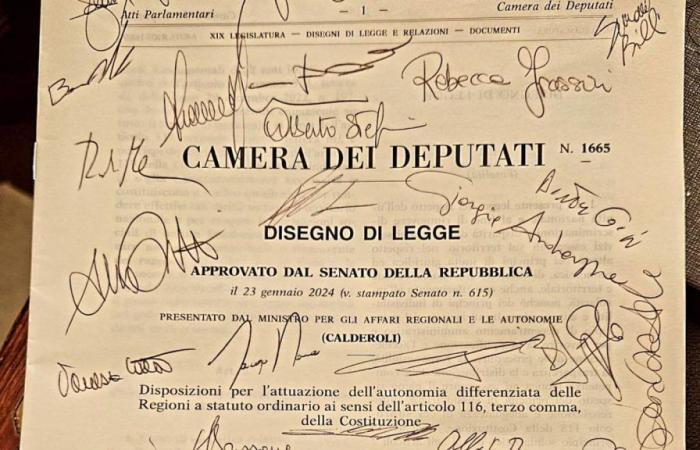
In a few hours, Parliament gave the green light to two reforms strongly desired by the Meloni government. Yesterday, with 109 votes in favor and 77 against, the Senate approved the premiership, the reform that redefines the constitutional balance by reviewing the powers of the President of the Republic and that of the Council. The ball now passes to the Chamber, which will discuss the text in three months. This morning, however, after a long nocturnal marathon, the Chamber gave the second and definitive Yes to differentiated autonomy, with 172 in favour, 99 against and one abstention.
Premiered These are the main points of the Casellati bill, named after the Minister for Constitutional Reforms Maria Elisabetta Casellati.
1) Direct election of the Prime Minister by universal suffrage
2) Limit of two consecutive terms (each of five years). You can only be prime minister for a third legislature if “in previous years has held the position for a period of less than seven years and six months”.
3) Power to appoint and dismiss ministers. “The President of the Republic gives the elected Prime Minister the task of forming the government; appoints and dismisses the ministers, upon his proposal”. In the current Constitution there is no power to dismiss ministers.
4) Question of trust. “Within ten days of its formation the government presents itself to the Chambers to obtain their confidence”. If the motion is not approved, “the President of the Republic renews the mandate of the president-elect to form the government”. So the elected prime minister can make a new attempt with another team of ministers, or even seeking another majority. “If even in this last case the government does not obtain the confidence of Parliament, the President of the Republic proceeds to dissolve the Chambers”.
5) The mechanism of government crises changes. If the government, during the legislature, is given a vote of no confidence “through a reasoned motion, the President of the Republic dissolves the Chambers”. In the event of resignation, however, “the elected Prime Minister, within seven days and after parliamentary information, has the right to request the dissolution of the Chambers from the President of the Republic, who orders it. If the elected Prime Minister does not exercise this power, the President of the Republic confers the task of forming the government, only once during the legislature, to the resigning Prime Minister – who can therefore change the majority – or to a parliamentarian elected in liaison with the Prime Minister”. “In cases of forfeiture, permanent impediment or death of the elected Prime Minister, the President of the Republic confers the task of forming the government, only once during the legislature, to a parliamentarian elected in liaison with the Prime Minister” .
6) There will no longer be senators for life. The Quirinale’s power to appoint five senators for life was repealed; however, those currently in office retain their positions. The bill does not, however, modify the article which establishes that the presidents of the Republic become senators for life at the end of the seven-year term.
7) Countersignature abolished. Lcountersigned by the government in a series of acts of the President of the Republic – appointment of the Prime Minister, appointment of judges of the Constitutional Court, granting of pardons and commutation of sentences, decree calling for elections and referendums, messages to Parliament, postponement of laws in the Chambers – has been abolished.
8) Election of the President of the Republic. To elect the head of state, a quorum of two thirds of the electors will no longer be needed in the first three ballots but in the first six.
In all of this, some points remain to be clarified. For example: what percentage will be needed to be elected? Is there a runoff? How will we guarantee a majority for the prime minister in both chambers? Another theme is that of the vote of Italians abroad. The reform speaks of “universal and direct suffrage” for the election of the prime minister and therefore the vote of the almost 5 million Italians living abroad would be worth the same as that of citizens living in Italy, including the hypothesis that their vote could overturn the outcome of the vote expressed by Italians resident in Italy. However, in the Constitution, Italians abroad are only given a “right to the tribune”, given that despite being 10% of the electoral body, only 8 deputies and 4 senators express their votes.
All these points will be resolved with the ordinary law and with the electoral reform, as clarified by Minister Casellati.
Differentiated autonomy These are the main points of the Calderoli bill, named after the Minister for Regional Affairs Roberto Calderoli
These are the main points:
1) Requests for Autonomy arise on the initiative of the Regions themselves, after consultation with local authorities.
2) There are 23 subjects, including health protection. Then there are, among others, Education, Sport, Environment, Energy, Transport, Culture and Foreign Trade. Of these, 14 are defined by Lep, the essential performance levels, i.e the criteria that determine the minimum service level that must be guaranteed uniformly throughout the national territory.
3) Determination of Lep. The granting of one or more “forms of autonomy” is subordinated to the determination of the Leps. The determination of costs and standard needs, therefore of the Lep, will take place starting from a survey of the historical expenditure of the State in each Region in the last three years.
4) Transfer principles. Article 4 establishes the principles for the transfer of functions to the individual Regions and specifies that it will be granted only after the determination of the Lep and within the limits of the resources made available in the budget law. Therefore, without the Leps and their financing, which must also be extended to the Regions that do not request devolution, there will be no Autonomy.
5) Creation of a control room, composed of all the competent ministers and assisted by a technical secretariat, which will be located in the Department for Regional Affairs and Autonomy of the Presidency of the Council. Its task will be to carry out a survey of the regulatory framework in relation to each administrative function of the state and of the ordinary regions, as well as identifying the subjects (or areas of subjects) relating to the Lep on civil and social rights that must be guaranteed throughout the national territory.
6) The times. Within 24 months of the entry into force of the Calderoli bill, the government will have to pass one or more legislative decrees to determine the Lep. The State and Regions will have 5 months from the request for autonomy to reach an agreement. The agreements may last up to 10 years and then be renewed, or they may end earlier but with at least one year’s notice.
7) Safeguard clause. The art. 11, in addition to extending the law to special statute regions and autonomous provinces, provides for a safeguard clause for the exercise of the substitutive power of the government. The executive, therefore, can replace the bodies of the Regions, metropolitan cities, provinces and municipalities when it is found that the bodies concerned are in breach of international treaties or community legislation, or if there is a serious danger to public safety and it is necessary to protect the legal or economic unity. In particular, the protection of essential levels of civil and social rights benefits is mentioned.



